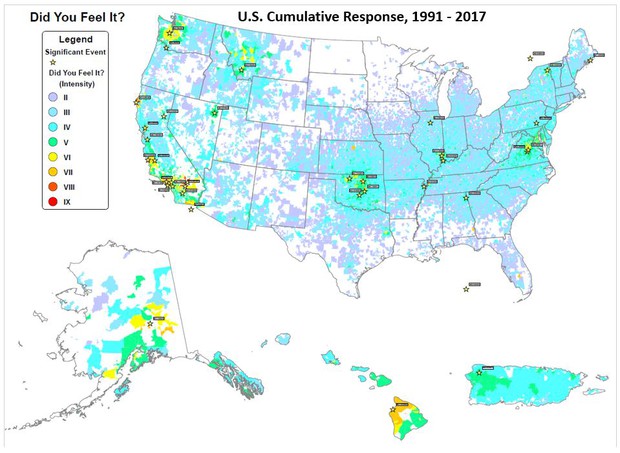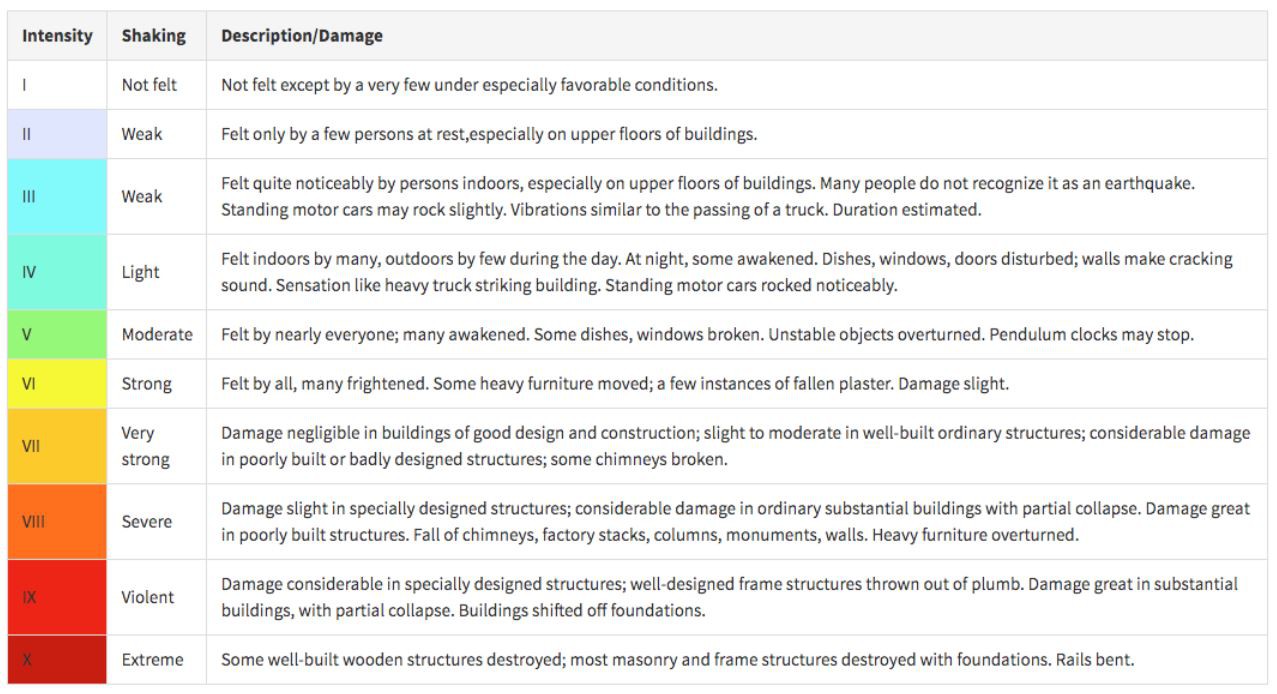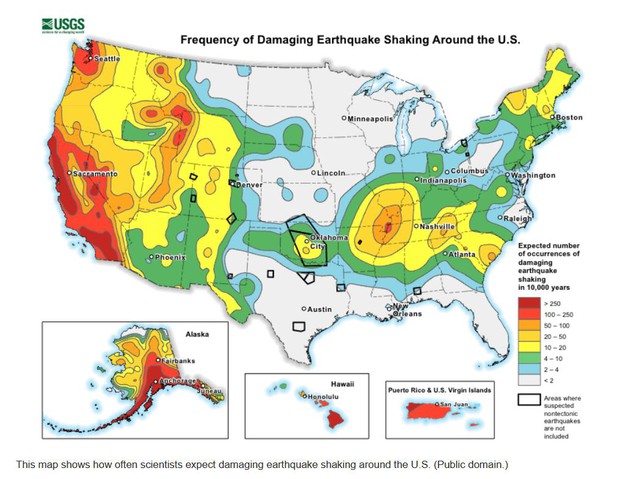High School | Daily Do
Why Should We Prepare for Earthquakes?

Citizen Science Earth & Space Science Is Lesson Plan NGSS Performance Expectations Phenomena Science and Engineering Practices Three-Dimensional Learning High School Grades 9-12
Sensemaking Checklist




Introduction
In today's task, Why should we prepare for earthquakes?, students observe the phenomenon of people in every state experiencing shaking caused by earthquakes in the past 26 years. Students engage in the science and engineering practices of analyzing data and obtaining information which leads them to ask investigatable questions about earthquakes. They also consider their role in protecting themselves, their families, and members of their communities from harm during and after an earthquake.
Did you feel it?! At 2:00 am ET this morning (9/9/20), a 3.1 magnitude earthquake occurred near East Freehold, New Jersey. Earthquakes also occurred near Pahala, HI and The Geysers, CA. Do you live in or around these areas? Contribute your experience to the USGS intensity maps (even if you didn't feel shaking) and help geologists and agencies tasked with emergency response learn from these event.

Experience the Phenomenon
Say to students, "I have a phenomenon I'm excited to share with you!" Ask students to prepare a space in their science notebooks to record observations and any questions that arise. Share the Did You Feel It? U.S. Cumulative Response, 1971-2017 map with students and ask them to make and record observations. If students have their own computer, tablet, or phone, you might share the link to the map with them and let them view it on their own device. Encourage students to look at the map as a whole as well as individual earthquakes. Zooming in on an epicenter (star) reveals the magnitude/size (M) and date of the event.
Note: Tell students significant events are characterized by a combination of magnitude, number of people who submit the Did You Feel It? report, and number and type of emergency response agencies contacted. For example, a high magnitude earthquake that occurs in an unpopulated area would not be represented on this map.
Ask students to share their observations and questions with a partner. Then, move students into small groups and ask them to identify patterns in their data (observations). As you move around the room, listen for students to share the following patterns (suggested teacher follow-up questions):
- not all earthquakes are found on the west coast Where else do earthquakes occur?
- earthquakes aren't evenly distributed across the country How would you describe the pattern of significant earthquakes?
- earthquakes have been "felt" in every state
- higher intensity colors (red, orange, and yellow) are found near the epicenter Is this always the case?
- significant events on the west coast have higher magnitudes than significant events in the middle and eastern states Can you quantify your observation?
- lower magnitude earthquakes in the middle and eastern states have the same/nearly the same intensities as the higher magnitude earthquakes on the west coast
If you hear students trying to explain the patterns in data, you might say, "We're interested in the what right now, not the why." Encourage these students to try to find at least one additional pattern.
Bring the students back together to share patterns they identified with the class. Begin by calling on students who shared the ideas listed above. Create a class list of patterns. You might indicate on the list how many groups noticed the same patterns. If students share questions, ask them to record the questions in their science notebooks; you will call for questions later.

Next, share the modified Mercalli intensity scale descriptions, and Did You Feel It? questions with students. (Ask students not to submit a completed Did You Feel It? questionnaire - unless you have just experienced an earthquake.) You might put students in pairs and ask one student to read the intensity scale descriptions and the other to read the Did You Feel It questions. Consider using a 3-2-1 reading strategy and ask students to record and then share with their partner:
- 3 things learned
- 2 interesting facts
- 1 question
Ask students, "Which patterns (refer to the class list of patterns) might the intensity scale descriptions and Did You Feel It? questions help us explain?" Students will likely identify the pattern lower magnitude earthquakes in the middle and eastern states have the same/nearly the same intensities as the higher magnitude earthquakes on the west coast. Ask students to turn and talk with their partner or small group before sharing their ideas about how this information helps explain the pattern with the class. Students will likely say
- people who live in the middle and eastern states might report they were really scared during an earthquake because they aren't used to them/haven't felt one before
- people in the middle and eastern states might have more things on their shelves/hang things on the wall less carefully/live in different kinds of buildings than people who live on the west coast because they aren't expecting earthquakes
Consider adding these ideas to the class list of patterns.
Ask students, "Can we explain all of the intensity patterns we observed using information from the intensity scale descriptions and Did You Feel It? questions?" Again, ask students to turn and talk to a partner before sharing ideas with the class. Students might say we still haven't explained why intensity doesn't go from highest to lowest away from the earthquake epicenter like a "bullseye" or "target" pattern.
Ask students to return to their initial observations and questions and to record any new questions they have. Then, ask students to choose one question to share with the class. Create a space for a driving question board. You might ask one student to volunteer to share and post their question first, and then call on the next student. Continue in this way until all students have an opportunity to share and post their questions. Encourage students to post related questions near each other on the board. Student questions will vary, but common themes that will emerge likely include:
- Why don't all earthquakes occur in California/west coast?
- Can an earthquake happen here?
- How often do earthquakes happen here?
- Could we feel an earthquake?
- Can earthquakes be predicted?/Can animals predict earthquakes?/Is there such a thing as "earthquake weather"?
- How do you stay safe during an earthquake?
- What is an earthquake?
- Why are some earthquakes bigger than others?
- Can you make buildings totally earthquake-proof?
You might say to students, "Because we observed the pattern earthquakes have been felt in every state and many of us are wondering how to stay safe in an earthquake, should we answer this question first?"
Earthquake Safety
Play When the Earth Shakes video for students. Next, ask students to create a table labeled Before, During, and After Earthquake. Play the video again, this time asking students to record what to do before, during, and after an earthquake to stay safe. Ask students to share their completed tables with a partner. Then ask students to share information from their tables with the class and create a class earthquake safety table.
You might then share the Frequency of Damaging Earthquake Shaking Around the U.S. map with students. Consider teaming with a math teacher to facilitate grade-appropriate discussions about probability with students. If circumstances don't allow an integrated approach, consider the following prompts:
- What is the expected number of occurrences of damaging earthquake shaking in the next 10,000 years where we live?
- Could there be more occurrences? Less occurrences? Why do you say so?
- When within the next 10,000 year might damaging earthquake shaking happen? Why do you say so?
Refer students back to the list of class questions. What questions can we now answer?
Consider navigating students into a building understanding discussion about whether we (our school, our community) should prepare for damaging earthquake shaking. You might ask:
- What are some of your claims?
- How did you arrive at that conclusion? (What's your evidence?)
- Does any group have evidence to support Group A's claim?
- What else do we need to find out? What should we do next?
If students agree they should prepare for damaging earthquake shaking, consider registering for a Great ShakeOut Earthquake Drill. (And they can join millions of people performing earthquake drills on International ShakeOut Day, which is always the third Thursday of October.)


